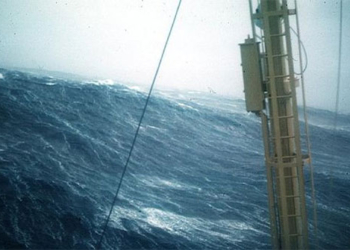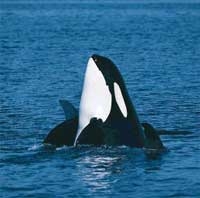Living on the Earth’s surface, we often think of tropical rainforests as the green lungs of the planet. For hundreds of millions of years, rainforests have continuously absorbed large amounts of carbon dioxide (CO2) from the atmosphere and produced oxygen to support life for various animal species.
However, to be fair, it turns out that the Earth is also breathing through even larger lungs found beneath the ocean, an ecosystem that few of us are aware of: These are the seagrass meadows.
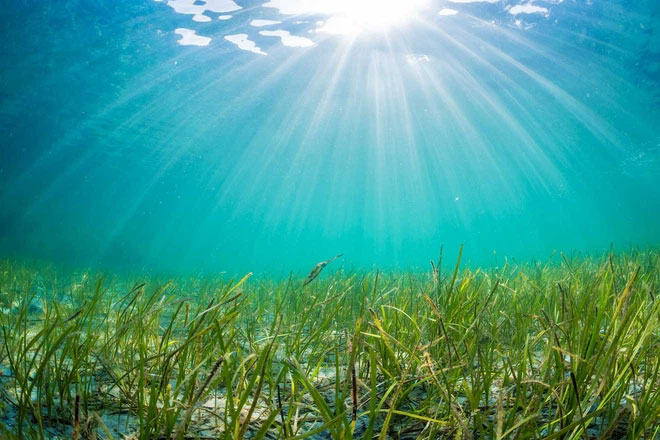
Seagrass meadows.
Seagrasses are not seaweed, algae, or coral. They are true plants that once lived on land. Seagrasses belong to the group of monocotyledonous plants. They have roots, leaves, flowers, and even their flowers can be pollinated underwater.
This plant group shares a common ancestor with terrestrial grasses, but about 100 million years ago, seagrasses found their way to dive down and grow on the ocean floor. Here, they continue the tradition of photosynthesis, exchanging CO2 and oxygen as usual.
Each square meter of seagrass can produce 10 liters of oxygen per day through photosynthesis. They also absorb carbon at a rate 35 times faster than tropical rainforests. Seagrass ecosystems are among the largest carbon sinks on the planet. Despite covering only 0.1% of the ocean floor, these organisms store 11% of the carbon found in the ocean.
Even scientists are surprised by the carbon absorption capacity of seagrass.
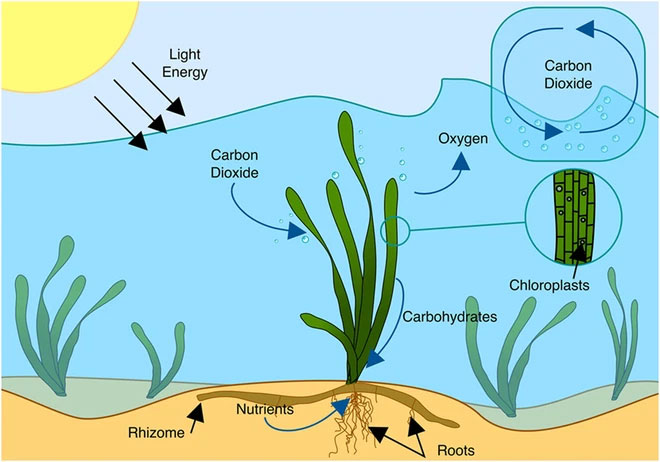
Seagrass has roots, leaves, flowers, and even flowers can be pollinated underwater.
But what has enabled seagrass to outperform rainforests in the task of filtering CO2 for the Earth? It turns out that hidden beneath the seagrass meadows is a secret hero. Without the presence of this organism, seagrass would wilt and lose almost all of their carbon capture capabilities.
In a recent study published in the journal Nature, scientists discovered a type of bacteria called Celerinatantimonas neptuna in the roots of Neptune seagrass (Posidonia oceanica). This bacterium converts nitrogen into a nutrient that seagrass needs for photosynthesis.
This process is known as nitrogen fixation. The bacterium C. neptuna seems to have followed seagrass during their migration from land back to the ocean around 100 million years ago. The close friendship between these two organisms has helped make the Earth greener than ever.
On the migration back to the seabed
We know that all terrestrial plants actually evolved from a group of green algae about 450 million years ago. When they were still algae in the sea, they had no roots, no flowers, and absorbed nutrients through the process of osmosis rather than from roots anchored deep in the seabed.
As they emerged from the water’s surface, plants began to equip themselves with specialized reproductive and metabolic absorption systems such as roots, stems, leaves, flowers, and seeds. Like algae, plants also photosynthesize, but they use only chlorophyll and carotenoids instead of phycobilin pigments.
Clearly, terrestrial plants represent a much more advanced form of evolution compared to sea algae. Algae can exist in unicellular or filamentous forms and live a drifting life in the ocean, but plants cannot; they must be multicellular, have complex bodies, and roots that anchor them to the ground.
However, around 70-100 million years ago, a group of plants living around mangrove swamps suddenly wanted to abandon the atmosphere and migrate back to the ocean. They dominated shallow water areas to continue capturing sunlight for photosynthesis.
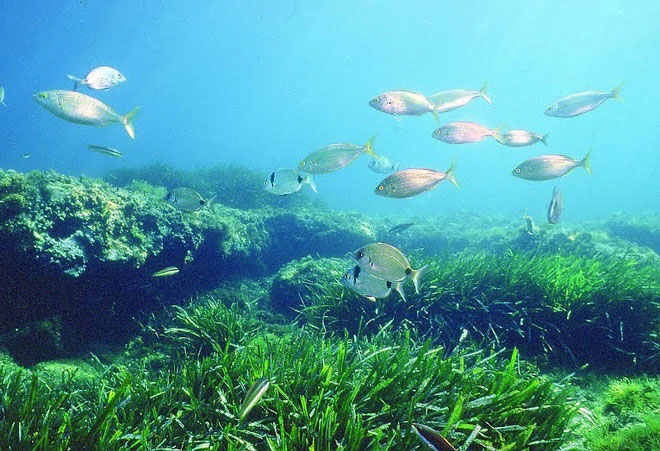
Terrestrial plants are clearly a more evolved form compared to sea algae.
Gradually, these plants made their way down to depths of 60 meters, proliferating and developing into over 60 species belonging to 5 different subfamilies. They cover vast marine areas, which can reach up to 4,500 square kilometers, forming meadows on the continental shelves of all continents except Antarctica.
At this point, there’s no need to reiterate that we are talking about seagrass and their admirable migration. But what we haven’t mentioned is that the success of seagrass in re-invading the ocean is also due to a symbiotic organism, nitrogen-fixing bacteria.
Seagrass needs nitrogen, but where do they get it from?
Nitrogen or nitrogen-containing compounds are essential components for all life processes, both in animals and plants. In our human bodies, nitrogen is a building block for DNA, proteins, and each amino acid and nucleotide.
In plants, nitrogen is an indispensable component for the formation of chlorophyll, the compound that helps them photosynthesize, absorb CO2, sequester carbon, and release oxygen. A lack of nitrogen can stunt plant growth, preventing them from sprouting leaves. A deficiency in chlorophyll causes leaves to turn yellow, adversely affecting photosynthesis.
This should have been the case for seagrass as they transitioned from land to the ocean floor. This is because, unlike algae that can obtain nitrogen from water and convert it into ammonia or nitrate for use, seagrass, being descendants of land plants, must extract nitrogen from the soil through the nitrogen fixation process carried out by bacteria.
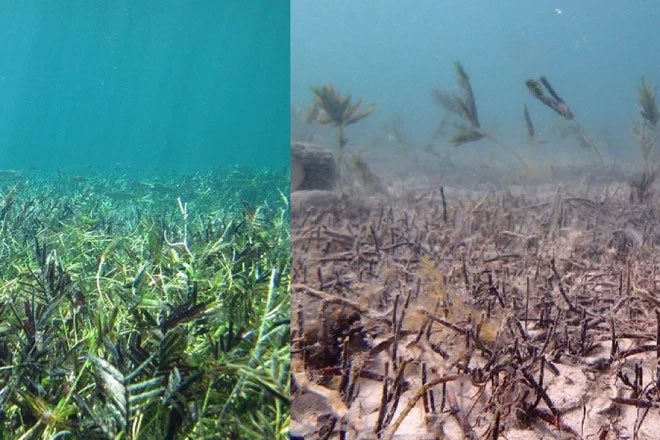
In plants, nitrogen is an essential component for forming chlorophyll.
Even though the atmosphere is filled with nitrogen, plants cannot absorb that gas to survive. They require bacteria to convert nitrogen into forms that roots can absorb, such as ammonia or nitrate for plant use. This conversion process is known as nitrogen fixation. Unfortunately, the seabed does not contain as many effective nitrogen-fixing bacteria as found on land.
This indicates that something else must have converted and provided nitrogen for seagrass to thrive. Wiebke Mohr, a marine biologist from the Max Planck Institute in Bremen, Germany, was very curious about this question.
In his study, he and his colleagues collected Neptune seagrass (Posidonia oceanica) from the Mediterranean region and the surrounding sediments. After bringing them back to the lab, they stained the samples with various dyes to highlight each type of bacteria present.
The results showed the presence of a completely new strain of bacteria in the roots of seagrass. Mohr and his colleagues named this bacterium Celerinatantimonas neptuna and noticed that C. neptuna often appears abundantly in seagrass roots during the summer, which is when nitrogen is most scarce. It seems that these bacteria are the ones helping seagrass fix nitrogen.
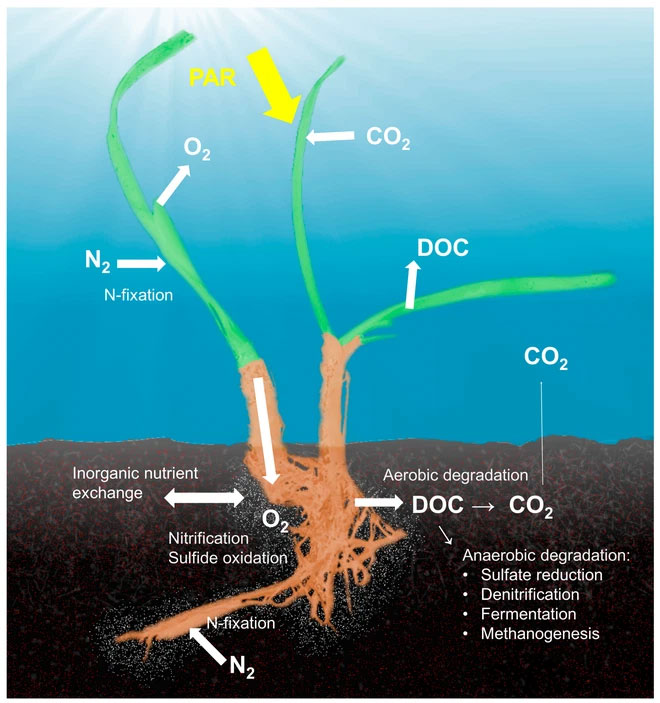
It appears that the bacteria Celerinatantimonas neptuna help seagrass fix nitrogen.
“Previously, other scientists believed that the so-called fixed nitrogen that seagrass used came from bacteria living around their roots on the ocean floor. But now, we have proven that this is a much closer relationship:
The nitrogen-fixing bacteria live right inside the roots of seagrass, not outside and in the soil. This is the first time such a close symbiosis has been demonstrated in seagrass,” Mohr said.
Two companions
On land, we have legumes that also host nitrogen-fixing bacteria right inside their roots, where they form nodules. However, this type of symbiotic relationship has never been observed in any marine plant species.
Now, Mohr and his colleagues have demonstrated that seagrass in the Mediterranean also carries a type of nitrogen-fixing bacteria, C. neptuna, within their roots. But since the relatives of this bacterium are found all over the world, Mohr suggests that similar symbiotic relationships may also occur with other seagrass species in different marine regions.
The bacteria C. neptuna greatly benefit from their symbiotic relationship with seagrass. They require energy to function, as the process of converting nitrogen into ammonia or nitrite is very energy-intensive. Seagrass provides a home and also sugar molecules to nourish these bacteria.
In return, C. neptuna fixes nitrogen for them. Once seagrass obtains nitrogen from the roots, it quickly transports this element to nourish its leaves and enhance photosynthesis. “This transfer occurs very rapidly, with about 20% of the newly fixed nitrogen being assimilated into leaf biomass within 24 hours,” Mohr and the authors of the new study stated.
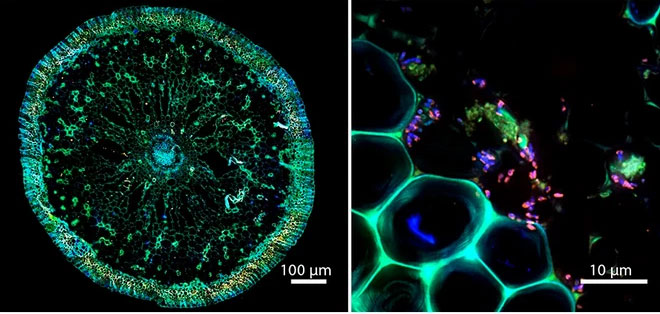
Dyeing samples with different dyes, scientists have discovered a bacterium that helps seagrass fix nitrogen.
This symbiotic system has been functioning smoothly for hundreds of millions of years, and it is clear that *C. neptuna* plays a crucial role in the migration of seagrass from land into the ocean depths. However, the origin of this bacterium remains unclear.
While Mohr found genetic evidence suggesting that the ancestors of *C. neptuna* once formed a symbiosis with algae—a rootless species—he also discovered that its closest living relatives are currently symbiotic with salt marsh grasses.
Thus, there are two hypotheses: one is that *C. neptuna* abandoned algae to follow seagrass. Alternatively, this friendship may have formed earlier when seagrass was still on the salt marshes, where they befriended *C. neptuna* and later brought their companion down into the ocean.
Why do we need to protect this friendship and ecosystem?
Regardless of how and when seagrass began receiving help from *C. neptuna*, their combination today not only tells a success story for their friendship but also for an entire ecosystem within the ocean and on land.
Seagrass meadows provide shelter and are a rich food source for many marine species. The canopies of seagrass are hiding places, nurseries, and habitats for small invertebrates like shrimp, crabs, small fish, juvenile fish, and even larger fish.
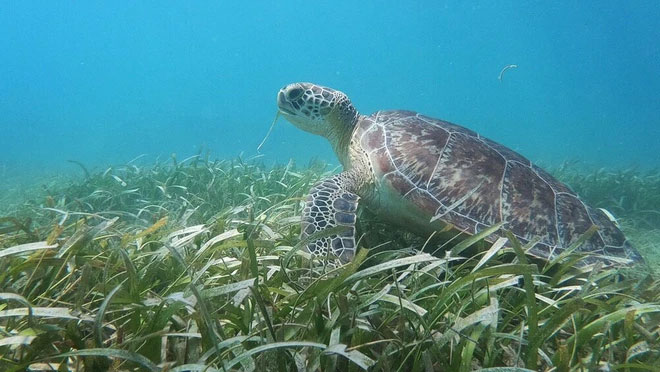
Seagrass meadows are a rich food source for many marine species.
Seagrass is also food for many marine creatures, including endangered species such as manatees, green turtles, and sea snakes. Each day, an adult manatee can consume about 28 to 40 kg of seagrass, while an adult sea turtle consumes about 2 kg. If seagrass disappears, these animals will have nothing to eat.
Not only is seagrass important for the ocean, but it also serves as a massive CO2 reservoir for the atmosphere. Similar to terrestrial plants, seagrass absorbs CO2 from the air and releases oxygen during its life processes.
When seagrass dies and decomposes on the seabed, the CO2 it previously absorbed gets buried in the ocean sediment. Currently, seagrass populations are helping us store approximately 27.4 million tons of CO2 over an area of about 600,000 km² of continental shelf.
Regrettably, we are destroying seagrass meadows at an even faster rate than tropical rainforests. Statistics indicate that 18% of the world’s seagrass area has vanished in just a few decades, equivalent to an area of over 30,000 km².
WWF’s seagrass conservation project: Sowing 1 million seeds to plant 1 million hopes.
On average, the world loses an area of seagrass equivalent to 2 football fields every hour. This is primarily due to human activities that pollute the seabed with solid waste, heavy metals, floating debris, or oil spills.
Additionally, fishing activities that use explosives, chemicals, and bottom trawling can also destroy seagrass beds. Because seagrass typically thrives in shallow waters, land reclamation activities, construction projects like roads, housing, ports, and even aquaculture can impact the ecosystem of the seagrass fields below.
Given the significant contribution of this ecosystem to the health of the planet, it is time we raise awareness among individuals, organizations, and governments about seagrass and the symbiotic bacteria in their roots.
Research like that of Mohr and colleagues is helping to drive this process forward. The more we understand about seagrass and the factors that help them thrive, the better measures we can take to conserve and restore this vital ecosystem.








































